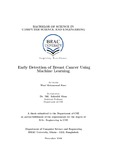| dc.contributor.advisor | Alam, Dr. Md. Ashraful | |
| dc.contributor.author | Fuad, Wasi Mohammad | |
| dc.date.accessioned | 2019-04-17T05:26:35Z | |
| dc.date.available | 2019-04-17T05:26:35Z | |
| dc.date.copyright | 2018 | |
| dc.date.issued | 2018-12 | |
| dc.identifier.other | ID 14201029 | |
| dc.identifier.uri | http://hdl.handle.net/10361/11723 | |
| dc.description | This thesis is submitted in partial fulfillment of the requirements for the degree of Bachelor of Science in Computer Science and Engineering, 2018. | en_US |
| dc.description | Cataloged from PDF version of thesis. | |
| dc.description | Includes bibliographical references (pages 39-41). | |
| dc.description.abstract | Breast cancer is the most common cancer among women but in can occur in both the genders.
It is accountable for an appalling number of deaths worldwide. In a particularly low-resource
developing country like Bangladesh, there is a lack of awareness and facilities mostly in rural
areas and high rate of instances of breast cancer that is diagnosed in the last stages. However,
the early detection of breast cancer can lead to help increase the odds of survival. Nowadays,
with the increasing number of patients, manual analysis of medical images becomes tedious,
time consuming and unfeasible. With the advancement in the field of machine learning,
it is now possible to create an automated and accurate Computer Aided Diagnosis (CAD)
system in order to make the entire process of detecting a malignant tumor more resource
efficient and time saving through proper utilization. This paper presents the comparative
analysis of different machine learning algorithms and their results in predicting cancerous
tumors. The proposed model uses supervised machine learning algorithms such as Random
Forest, Support Vector Machine, K-Nearest Neighbors, Naïve Bayes and Logistic Regression
with and without PCA on a dataset with 30 features extracted from a digitized image of a
fine needle aspirate (FNA) of a breast mass. Deep learning models like Artificial Neural
Network and Convolutional Neural Network are used and their performances are compared.
From the comparative analysis, it is observed that the deep learning models outperform all
other classifiers and achieves impressive scores across multiple performance metrics such as
Accuracy of 98.83%, Precision of 98.44% and Recall of 100%. | en_US |
| dc.description.statementofresponsibility | Wasi Mohammad Fuad | |
| dc.format.extent | 41 pages | |
| dc.language.iso | en | en_US |
| dc.publisher | Brac University | en_US |
| dc.rights | Brac University theses are protected by copyright. They may be viewed from this source for any purpose, but reproduction or distribution in any format is prohibited without written permission. | |
| dc.subject | Breast cancer | en_US |
| dc.subject | Machine learning | en_US |
| dc.subject | Computer aided diagnosis | en_US |
| dc.subject | Random forest | en_US |
| dc.subject | Logistic regression | en_US |
| dc.subject | Artificial neural network | en_US |
| dc.subject.lcsh | Machine learning. | |
| dc.subject.lcsh | Breast--Cancer--Diagnosis. | |
| dc.title | Early detection of breast cancer using machine learning | en_US |
| dc.type | Thesis | en_US |
| dc.contributor.department | Department of Computer Science and Engineering, Brac University | |
| dc.description.degree | B. Computer Science and Engineering | |

